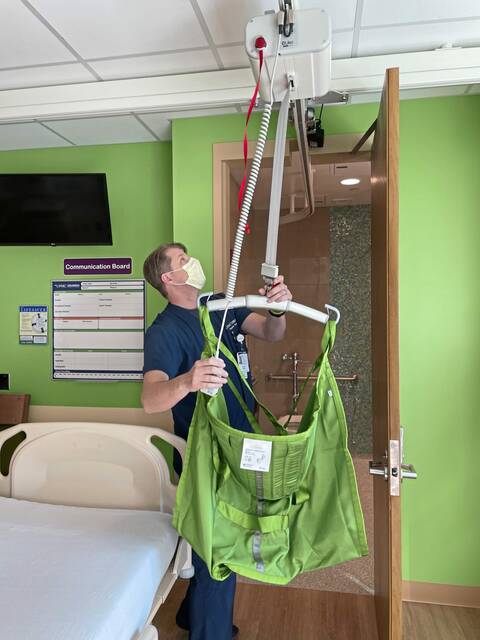UPMC Children's Hospital to open new rehab facility
For some kids who suffer from brain trauma or spinal injury, one of the goals they may set for rehabilitation is being able to sit on the floor to play with their pet dog.
The Zero G robot, a new supportive harness system for patients to practice walking, balance and getting up and down, is one of the high-tech features at UPMC Children’s Hospital of Pittsburgh to help them achieve such goals.
Children’s Hospital expects on Monday to admit patients into its new rehabilitation facility for children and young adults with brain trauma, spine injury, and other severe nervous system disorders.
UPMC gave a tour of the unit on Wednesday.
Katelyn Kelly, an occupational therapist, was strapped into the Zero G harness to demonstrate the support it provides for patients working on their mobility. She walked, did lunges and did a free fall while the system held her steady and monitored her activity.
“The first feature of the system is protecting the child walking up and down,” explained physical therapist Erik Trentrock. “If you think about the safety of the system, we can provide this high intensity therapy to our kids. And we know that intensity matters for recovery.”
Previously, the children’s rehab facility was housed at The Children’s Home of Pittsburgh, down the street on Penn Avenue in Lawrenceville.
The space now will be inside the hospital, allowing it to more easily share amenities with the rest of Children’s Hospital and more easily transition patients from intensive care to rehab, said Diane Hupp, president of Children’s Hospital.
The facility has expanded from eight to 12 beds and doubled the space. It took two years from start to finish, Hupp said.
The hospital expects to see about 150 patients a year through the unit, she said.
“The intent of this children’s inpatient rehab unit is truly to help to normalize the child and progress to the highest level of functioning toward independence,” Hupp said. “We’ve expanded to 12 beds, all private rooms with state-of-the-art technology.”
Patients typically stay three weeks, but the time can vary. Ages range from toddlers to young adults.
The unit has a room with a dishwasher, refrigerator and microwave to help kids practice the movements they will need as they readapt to their lives at home. Within the dozen private rooms are features such as another supportive harness system secured to tracks along the ceiling to help kids move from the bed to the bathroom or more easily move to a wheelchair.
A teacher, recreation specialist, speech pathologist and other specialists are on staff to create a “multidisciplinary approach” to the process, Hupp said.
Remove the ads from your TribLIVE reading experience but still support the journalists who create the content with TribLIVE Ad-Free.




